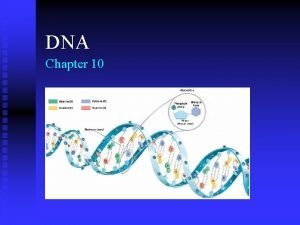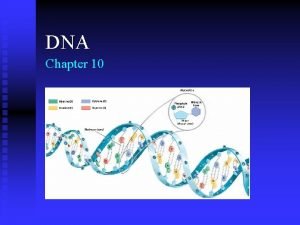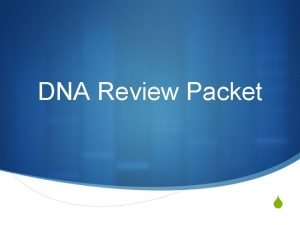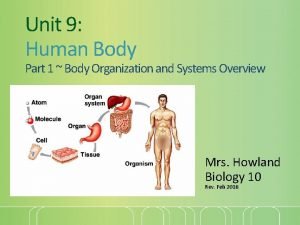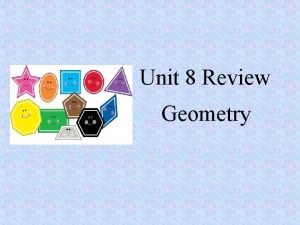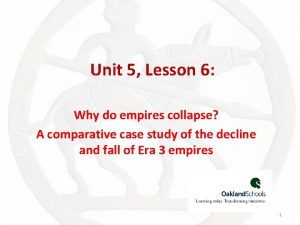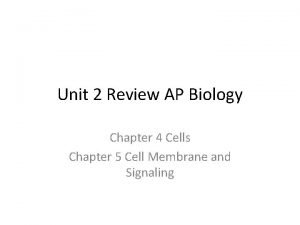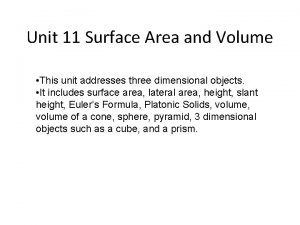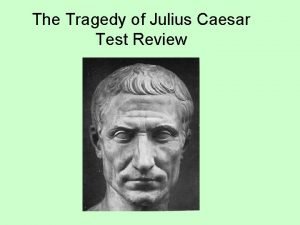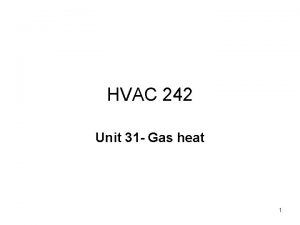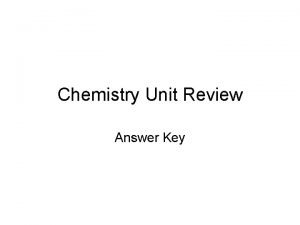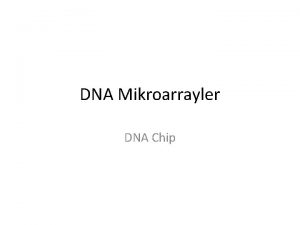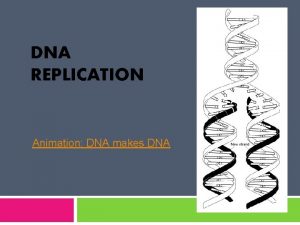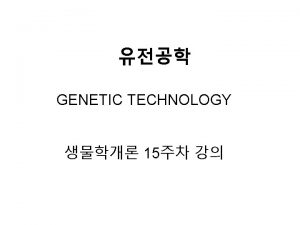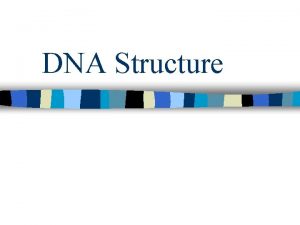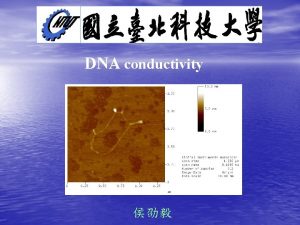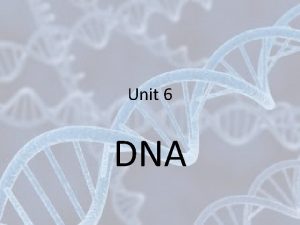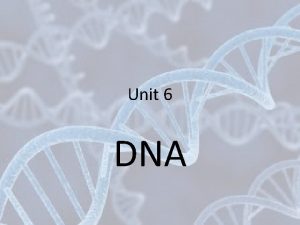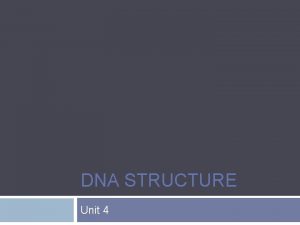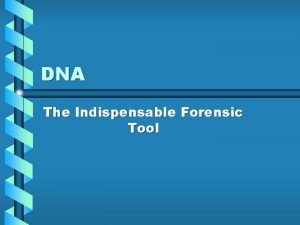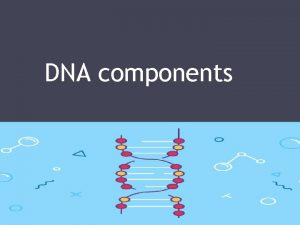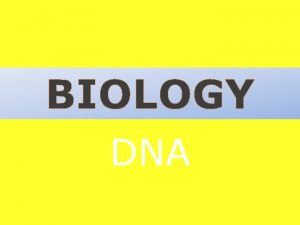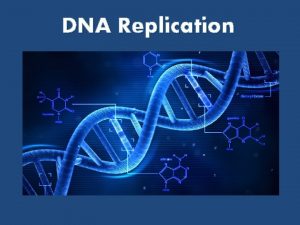DNA Review Unit 4 DNA Review DNA is




























- Slides: 28

DNA – Review Unit 4

DNA - Review �DNA is found inside the _____ of a cell. �What is the role of DNA in living organisms? �List the four base pairs found in DNA.

DNA - Review �Draw a nucleotide of DNA. Label the parts and the type of bond between two nucleotides. �Include the following parts: Phosphate Group, Nitrogen Base, Deoxyribose Sugar, Hydrogen Bond

DNA - Review �Fill in the Blank: Protein Synthesis DNA ___ Ribosome ___ TRAIT �Human Chromosome #15 holds the ____ Code to build the EYCL 3 ____ which expresses the genetic trait Brown Eyes in humans. �Bank: t. RNA, protein, m. RNA, DNA, protein

DNA 1. A strand of DNA is exposed to intense heat. Which of these best describes what will happen to the strand of DNA? A. The chemical bonds of the DNA molecule will be broken. B. More nitrogen base pairs will add on to the DNA molecule. C. The chemical bonds of the DNA molecule will be strengthened. D. The nitrogen base pairs in the DNA molecule will switch places.

DNA 2. What is the role of hydrogen bonds in the structure of DNA? A. To code for proteins B. To synthesize proteins C. To separate the strands D. To connect the base pairs

DNA 3. The following cell structures are located within cells that make proteins. Which description best explains the relationship among these cell structures? � Nucleus � Ribosome � Endoplasmic Reticulum (ER) A. Nucleus makes protein winds through the ER protein folds into its active shape B. Nucleus directs ER to assemble the protein ribosomes surround protein folds into its active shape C. ER creates protein DNA in the nucleus codes for ribosomes to surround protein folds into its active shape D. DNA in nucleus codes for protein assembled in ribosomes and moves to ER protein folds into its active shape

DNA 4. Which of these best describes the initial change caused by a DNA mutation? A. A change in the sequence of base pairs B. A change in the production of enzymes C. A change in the number of nucleosomes within a cell D. A change in the number of hydrogen bonds between the bases

DNA 5. The chromosome structure in a cell accounts for genetic variation based on the order of its A. Sugar groups B. Nitrogen bases C. Hydrogen bonds D. Phosphate groups

DNA 6. A strand of DNA has these bases: AGC CAT GTA TAC What is the complementary DNA strand? A. ACG GAT CTA TAG B. TCG GTA CAT ATG C. TGC CTA GAT ATC D. UCG CUA CAU AUG

DNA 7. Which of these shows the steps by which proteins are coded and synthesized? A. RNA→DNA→protein B. DNA→RNA→protein C. Protein→RNA→DNA D. Protein→DNA→RNA

DNA 8. Which statement best describes the relationship that exists among proteins, DNA, and cells? A. Proteins combine to produce cells, which produce DNA. B. Proteins are made up of DNA, which determines the cells that are produced. C. DNA is made up of proteins, which tell a cell how to function D. Cells contain DNA, which controls the production of proteins.

DNA 9. What are the subunits of DNA and their function? A. Nucleotides that store info B. Monosaccharides that provide quick energy for the cell C. Lipids that store energy and provide insulation D. Proteins that provide the building blocks for the structural components of organisms.

DNA 10. A segment of DNA has the sequence: ATA GCA CAT GTA What is the m. RNA sequence transcribed from the segment? A. TAT CGT GTA CAT B. TAT GCT CTA GAT C. UAU CGU GUA CAU D. UAU GCU CUA CAU

DNA 11. Which is a conclusion drawn from the observed DNA similarities found between apes and chimpanzees? A. Apes and chimps are in the same genus. B. Apes and chimps are the same species. C. Apes and chimps are products of artificial selection. D. Apes and chimps are thought to have evolved from a common ancestor.

DNA 12. Which describes the use of pieces of chromosomes to replace faulty or absent pieces that cause disease? A. Karyotyping B. Gene Therapy C. Nondisjuntion D. DNA Fingertyping

DNA 13. Which is common to both DNA and RNA? A. Uracil B. Thymine C. Cytosine D. Deoxyribose

DNA 14. Which is the complementary DNA sequence for the following segment of DNA? CTC CAA CTA A. CTG GAA CTA B. GAG GTT GAT C. TAT CAA GGT D. GAC CTT GAT

DNA 15. A DNA strand with the sequences of bases shown below is transcribed to m. RNA. ATT CGA GTT Which is the correct base sequence in m. RNA? A. ATT CGA GTT B. TAA GCT CAA C. TUU GCT CUU D. UAA GCU CAA

DNA 16 Who first proposed the double-helix structure of the DNA molecule? A. Pauling B. Mc. Clintock C. Watson and Crick D. Harris and Watkins

DNA 17. Which amino acids are coded for by an m. RNA segment that reads CAG GUG? A. Arginine and Valine B. Isoleucine and Arginine C. Glutamine and Valine D. Valine and Isoleucine See next slide…

DNA

DNA 18. Which base sequence cannot occur in RNA? A. TGCTAT B. GCUAGG C. CCUAAC D. AAGCCC

DNA 19. Which factor most affects the order of amino acids in a protein? A. The DNA located in the nucleus of the cell B. The cell in which the protein is located C. The amount of ATP available for the cell’s use D. The area in a cell where proteins are produced

DNA 20. How does DNA code for proteins in a cell? A. By creating a new double helix structure B. By using its phosphate and sugar molecules C. By adding more hydrogen bonds to its structure D. By arranging certain nitrogen bases of the cell in a particular order

DNA 21. How would overexposure to X-rays affect most animal cells? A. It would increase cell specialization in organs B. It would change the sequence of DNA nucleotides in affected cells C. It would produce new nucleotides for DNA molecules D. It would cause an increase in red blood cell production

DNA 22. Which amino acid is specified by the m. RNA code CCC? See next slide

DNA
 Unit 6 review questions
Unit 6 review questions Unit test algebra 2
Unit test algebra 2 Dna polymerase function in dna replication
Dna polymerase function in dna replication Bioflix activity dna replication lagging strand synthesis
Bioflix activity dna replication lagging strand synthesis Coding dna and non coding dna
Coding dna and non coding dna Enzyme involved in dna replication
Enzyme involved in dna replication Dna and genes chapter 11
Dna and genes chapter 11 Section 10-1 review discovery of dna
Section 10-1 review discovery of dna Discovery of dna section 10-1 review
Discovery of dna section 10-1 review Dna review packet
Dna review packet Chapter review motion part a vocabulary review answer key
Chapter review motion part a vocabulary review answer key Ap gov final review
Ap gov final review Nader amin-salehi
Nader amin-salehi What is inclusion and exclusion criteria
What is inclusion and exclusion criteria Narrative review vs systematic review
Narrative review vs systematic review Unit 9 human body systems review
Unit 9 human body systems review Unit 9 factoring review answers
Unit 9 factoring review answers Geometry unit 8 test
Geometry unit 8 test Unit 8 review logarithms
Unit 8 review logarithms Unit 7 lesson 5 review questions
Unit 7 lesson 5 review questions World history unit 5 lesson 6
World history unit 5 lesson 6 Ap biology unit 2 review
Ap biology unit 2 review Lateral surface area
Lateral surface area Chemistry semester 2 review unit 12 thermochemistry
Chemistry semester 2 review unit 12 thermochemistry Khubris
Khubris Period 3 key concepts apush
Period 3 key concepts apush Unit 31 gas heat
Unit 31 gas heat Hamlet unit test review
Hamlet unit test review Chemistry unit review answer key
Chemistry unit review answer key







